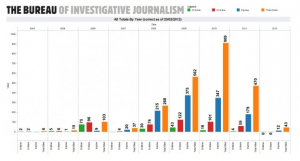CIA’s Drone Lies and Congressional Oversight
Remember when House Intelligence Chair Mike Rogers said that public reports of civilian drone casualties are wildly wrong?
“I think that you would be shocked and stunned how wrong those public reports are about civilian casualties,” Rogers said on the House floor.
“Those reports are wrong. They are not just wrong, they are wildly wrong. And I do believe that people use those reports for their own political purposes outside of the country to try to put pressure on the United States,” Rogers said.
Remember when Senate Intelligence Chair Dianne Feinstein said that civilian casualties have been in the single digits (and then went on to admit that she didn’t know about the “military aged male” standard)?
I’ve also been attempting to speak publicly about the very low number of civilian casualties that result from such strikes. I’ve been limited in my ability to do so. But for the past several years, this committee has done significant oversight of the government’s conduct of targeted strikes, and the figures we have obtained from the executive branch, which we have done our utmost to verify, confirm that the number of civilian casualties that have resulted from such strikes each year has typically been in the single digits.
These statements from members of the Gang of Four who have gotten the most unfettered sharing of intelligence on the drone strikes are why Jonathan Landay’s reports on what CIA’s own reporting shows are so important.
As I noted, Landay’s confirmation that CIA self-reported only one civillian casualty in the 12 months before September 2011 make it clear that CIA did not count any of the 40-something dead killed on May 17, 2011 at Datta Khel as civilian casualties.
At least 265 of up to 482 people who the U.S. intelligence reports estimated the CIA killed during a 12-month period ending in September 2011 were not senior al Qaida leaders but instead were “assessed” as Afghan, Pakistani and unknown extremists. Drones killed only six top al Qaida leaders in those months, according to news media accounts.
Forty-three of 95 drone strikes reviewed for that period hit groups other than al Qaida, including the Haqqani network, several Pakistani Taliban factions and the unidentified individuals described only as “foreign fighters” and “other militants.”
During the same period, the reports estimated there was a single civilian casualty, an individual killed in an April 22, 2011, strike in North Waziristan, the main sanctuary for militant groups in Pakistan’s tribal areas.
CIA reported no civilian casualties at Datta Khel even in spite of Mark Mazzetti’s report that “many American officials believed that the strike was botched, and that dozens of people died who shouldn’t have.”
Nor did the CIA count any of the (by my count) 51-176 civilian casualties reported by The Bureau on Independent Journalism for that period (2010; 2011; note, I counted September 1 to September 1).
In short, these reports prove that the CIA — and the intelligence community generally, given that these are described as US intelligence reports — are doing precisely what they did with the torture program: “repeatedly provid[ing] inaccurate information” to Congress.
Nevertheless, even as DiFi, at least, was seeing volumes and volumes of evidence that CIA had lied to Congress about torture in the very recent past, Gang of Four member staffers apparently didn’t read the public reporting on drones closely enough to realize that that public reporting was more credible than CIA reporting.
As a result, in spite of all the boasts of close oversight, CIA’s lies have turned the Gang of Four into propagandists for a program that they’re less well-informed about than many outside observers.
The intelligence oversight committees have become a classic case of Garbage In, Garbage Out, not only defying the entire point of oversight, but serving instead as a legally protected source of propaganda.
As we discuss releasing the torture report, we should also be discussing the larger issue of how CIA has perverted the only oversight structure it has. Because it has clearly become a pattern.

